past
issues

|
Published monthly for CC employees by Clinical
Center Communications
April 2000
"A soothing place of respite..."
Family Lodge
First graduate of NIH-Duke program
Volunteers break down language barriers
After 20 years, volunteer retires
Roger Mack retires after 34 years with CC
Ed Davis retires after 23 years with CC
Radiology's Ron Norman retires
CC'ers take part in diversity conference
News briefs
Studies
|
|
"A soothing place of respite..."
Plans move ahead for a Family Lodge near
Clinical Center
*Not their real names.
Emma* was just 21 years old when her sister, Jane*, was diagnosed
with bone cancer. Since her parents were elderly, it was difficult
for them to make the 70-mile trip to Bethesda to support and
care for Jane during her participation in a clinical trial. "So
I came to the hospital every three weeksor sometimes more
frequentlyduring her yearlong treatment," said Emma.
Emma's accommodations during these stays were patchwork at
best. "I could stay in her room some nights. I was lucky
enough to have a family friend in the area where I could stay
if need be. One night I slept in my car."
Paula*, who lives 400 miles away, in Ohio, is a participant
in a cancer vaccine protocol. She'll come to the CC several times
in the next few months. Her 23-year-old daughter wanted to come
with her for a recent visit, but "I told her no, because
I didn't want her to stay alone in a hotel," Paula said.
To help prevent such situations, the Clinical Center is working
diligently with the Foundation for the National Institutes of
Health and private donors to bring a Family Lodge to campus.
"The NIH Family Lodge will provide housing for the families
and loved ones of Clinical Research Center adult inpatients,"
said CC Director Dr. John Gallin.
The goal is to build a 35-unit facility with a comfortable,
homelike atmosphere, common areas for recreation and relaxation,
and a telecommuting center, which would allow family members
to keep in touch with their jobs or family back home. Individual
units will have a bedroom, sitting room, and possibly a kitchenette.
The concept has two NIH precedents: the Children's Inn and
the pilot NIH Guest House, which opened in 1996 in the old Apartment
House (Bldg. 20). With the demolition in 1998 of Bldg. 20 to
make way for the new Clinical Research Center (CRC), the 6-unit
Guest House moved to a nearby apartment building on Battery Lane
in Bethesda. As nice as that facility is, it doesn't provide
quite the added convenience to families that planners feel is
crucial to its mission.
The proposed site for the new Family Lodge is an area between
the Clinical Center and the Cloister. "We want to make it
easy for caregivers to walk back and forth between the Lodge
and the CRC so that they can get respite when needed, and get
quickly back to the CRC to be with their loved one," said
Jan Weymouth, project manager. "We also hope the Lodge will
provide a setting where caregivers can meet and interact with
others who are going through a similar event."
Emma agrees that proximity to the CC is crucial. "There
were nights when I would have opted to stay with [Jane] in her
room, but when that was not possible, a lodge just across the
street would have been wonderful. Also, in this part of the country
sometimes the weather makes it difficult to get to the hospital
even if you're staying a few miles away."
Private funds built the Children's Inn, and a similar arrangement
is in the works for the Family Lodge. Dr. Constance Battle is
the executive director of the Foundation for the National Institutes
of Health, the organization tasked with raising the estimated
$9 million to design and construct the facility. The Foundation
was created by Congress to provide support in areas not traditionally
funded by the government.
Half of the projected funds have already been raised thanks
to gifts of $1.5 million each from The Merck Foundation, Bristol-Myers
Squibb Foundation, and Glaxo Wellcome, Inc., according to Dr.
Battle.
A sick child's need to be near his or her parents makes a
poignant fundraising pitch. But, Dr. Battle points out, "90
percent of the patients at the Clinical Center are adults. They
have the very same family-centered needs that children have.
While any family member is receiving medical treatment, there
is a great deal of stress on other family members to be present
with the patient and to support them, yet meet the home obligations
and their own needs as well."
Emma agrees. "A lodge would be very important because
it gives the caregiver a chance to rest emotionally and physically
so they can give the best care they possibly can for their loved
one."
Although Emma was happy to help her sister through her illness,
"it was very tiring, very draining emotionally. There were
a lot of tears and questions and mixed emotions. It was financially
challenging to be there every time. A family lodge would relieve
not only the financial strain of trying to find a place to stay,
but also some of the emotional strain, because [where to stay]
is just one more question, one more problem to deal with. If
you can eliminate that from the pile of other worries, that's
one burden less."
According to Dr. Gallin, "The Family Lodge will also
provide transitional housing for patients and their family caregivers
after hospital discharge while they are learning the skills needed
to sustain care at home. If space is available, patients who
travel to NIH from long distances, but do not require hospitalization
(and their families) may use the facility."
That feature would be a big help to a patient such as Paula,
who stays with a cousin during visits that don't require an inpatient
admission.
"It is to hard to get [to NIH] from Alexandria at 7:30
in the morning without a car," she said. On her last visit,
she stayed in a nearby hotel, but reimbursement only covered
half the hotel fee. "A family lodge would be really nice."
The project is a priority, and fundraising efforts are in
high gear. The Foundation has released some funds to begin the
design process. Several architectural firms will present their
design concepts and qualifications this month.
"We'll be talking to patients and their families and
the medical team to get as many ideas as possible for the Lodge,"
said Dr. Battle. "It's not a complicated building, but we
want it to be right. We want it to be a soothing place of respite
and be accessible to the hospital."
For further information on the Family Lodge project, contact
Jan Weymouth at 6-2925. For information on fundraising efforts,
contact Dr. Battle at 2-5311.
--by Sue Kendall
Back to top
|
|
First graduate of NIH-Duke program
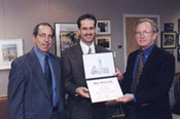
Dr. Douglas Shaffer, center, was the first student
to receive his Master of Health Sciences in Clinical Research
through the NIH-Duke Training Program in Clinical Research. Pictured
with him are, left, Dr. John Gallin, CC director, and, right,
Dr. William Wilkinson, Duke program director.
|
The NIH-Duke Training Program in Clinical Research (TPCR)
has its first graduate, Dr. Douglas Shaffer, a fellow with the
Division of Epidemiology and Clinical Applications of NHLBI.
Reflecting on his achievement, Dr. Shaffer said, "This
has been a remarkable experience. The TPCR goals of providing
formal training in quantitative and methodological principles
of clinical research have been exceeded. Not only am I better
prepared to conduct clinical research, I feel I'm a better clinician
as well."
The program, which began in 1998, is a collaboration between
the Clinical Center and Duke University, in Durham, N.C. It uses
distance-learning to strengthen training opportunities in clinical
research.
The program is designed primarily for clinical fellows and
other health professionals training for careers in clinical research.
Courses include research design, statistical analysis, health
economics, research ethics, and research management. NIH participants
complete coursework primarily through videoconferences with faculty
at Duke. NIH staff teach other courses as Duke adjunct faculty.
Dr. Shaffer cites the dedication of the faculty as an important
factor for the success of the program. "There was always
consistent, unequivocal support here and in Durham. About halfway
through the first semester, many in our group hit a point of
overall uncertainty," he said. Anxious feelings centered
on the magnitude of the commitment they had undertaken.
"Our statistics instructor from Durham, Dr. Sandra Stinnett,
came to Bethesda to meet with us not only as a group, but individually
as well. That speaks to the quality and dedication behind this
program." He says this same instructor would notice whenever
the Bethesda group became too quiet during a lecture. "She
could sense uncertainty on our end, and always quickly intervened."
The Duke University School of Medicine, which established
its program in 1986, awards a Master of Health Sciences in Clinical
Research for successful completion of the TPCR. The program can
be completed in two 16-week semesters; participants typically
spread course work over two years, an approach that Dr. Shaffer
recommends. Due to time constraints related to his fellowship,
he completed the coursework in one year.
"It's not optimum," he said. "You need to think
carefully about the best way to manage your time and complete
your regular work as well." He recommends having a research
project in mind before beginning the program, and he credits
supportive mentors, Drs. Larry Friedman and Peter Savage, for
allowing him flexibility in matching his work with his educational
goals.
Unfortunately, Dr. Shaffer has to miss the formal commencement
ceremony, to be held in Durham in May. But as he prepares to
move on in his career, he said of the TPCR, "It was the
highlight of my experience here. Was it hard? Yes. Bumpy? At
times. However, it was well worth the effort."
For details on this and other educational programs, consult
the Clinical Center's web site at http://www.cc.nih.gov,
and click on "Medical and Scientific Education."
--by Sue Kendall
Back to top
|
Volunteers break down language barriers
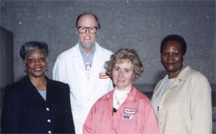
Some of the Clinical Center's volunteers.
From left to right, Anne Belton, Harry Canter, Susan Stevens,
and Josephine Diur.
|
Imagine being a sick little boy in a place where nobody spoke
your language and you didn't speak theirs. It could be pretty
scary.
But then, someone finally shows up who does speak your language.
And suddenly you aren't so scared anymore.
This situation is commonplace at the Clinical Center. And
the people who make it happen are the volunteer language interpreters.
Andrea Rander, director, Volunteer Services and Language Interpreters
Program, recalls one such volunteer, Gerti Tashko, a premed student
at the University of Maryland.
"He called me to see if there were any lab placements
available. I said I didn't have anything at the moment. He then
asked me if I needed a volunteer who spoke Albanian. I couldn't
believe it, because just the day before, I'd had a request for
an interpreter for an Albanian boy who spoke absolutely no English.
It was like a miracle. Gerti was so valuable to the patient and
his family. He worked with them during his summer break, and
he even worked with another volunteer, a former teacher, to help
the boy with his education."
Two more volunteer interpreters recently joined the CC. Amina
Gaber is from Egypt. She speaks Arabic and some French. She's
new to the area, having moved here from Michigan with her husband,
who works here. She picked up "CCNews" to learn more
about the place, saw a piece about interpreting, and contacted
Rander.
"I am enjoying it to the utmost," she said. "I'm
glad that I'm helping people as much as I can." Gaber is
also helping out in the Patient Representative Office.
Josephine Diur is from the Democratic Republic of Congo, and
speaks French and Swahili. She also helps out in the Rehabilitation
Medicine Department. Asked why she volunteers, she replied, "This
country has given me a lot and helped me a lot. Now I want to
give back."
Interpreting is just one of many ways volunteers give of their
time. Anne Belton, a retired teacher, started at the CC last
fall. She is one of the Hospitality Services Program volunteers
who greet and assist newcomers to the hospital. She decided to
volunteer after a visit to the CC with a group of patients. "I
was extremely impressed by the caring and sensitive staff. What
I see now is what I saw then. The people are wonderful and friendly,
and I meet people from all over. I love it."
Susan Stevens has been volunteering Mondays and Fridays for
about a year. She brings an assortment of magazines to patients'
rooms. "It is very rewarding to me because I have that one-on-one
relationship with some of the patients," she said. "Some
start a conversation, some don't. I'm there to talk to and provide
companionship if I am asked." She also helps out with paperwork
in one of the clinics.
Harry Canter is a fixture around the CC. He volunteers almost
every day, and he and his wife Floride run the flower shop. He
has been with NIH since 1951 and worked as a biologist for NCI.
He retired in 1993, but couldn't stay away from the place; after
all, his wife chairs the Red Cross volunteer desk. He also pitches
in wherever and whenever he's needed, from assisting with lecture
receptions, or checking audiovisual equipment in the auditorium,
or proofreading a lecture agenda.
Why does he volunteer?
"It's not the money," he joked. "It's the fringe
benefits. It's the nice people. I see a lot of friends from the
old work days too. I thought I'd give a little back for what
I got."
National Volunteer Week is April 915. Take a moment
to say "Thank you" to some of the dedicated people
who give their time and talents to make the Clinical Center tick.
--by Sue Kendall
Back to top
|
After 20 years, volunteer retires
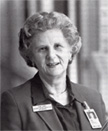
Joan Uhrig
|
Once the volunteer bug bites some people, they're hooked.
Such is the case for Joan Uhrig.
She began volunteering at the Clinical Center in 1980, and
has been here ever since. She spent most of her time with the
Patient Representative office, but she feels the time has come
to hang up that familiar red jacket and retire.
Uhrig, a native of New Zealand, began her career as a pediatric
nurse. She traveled to jobs in Australia, England, and Canada.
Then she and her husband came to the United States when he took
a position with the World Bank. "We were supposed to stay
4 or 5 years, and that's turned into 35 years," she said.
Unable to work in the U.S. as a nurse because of different
training requirements, she began to look for other meaningful
work. That search led her to the Red Cross. They suggested she
try volunteering at NIH.
At first, Uhrig provided support and assistance to families
in the waiting rooms. She later joined the Patient Representative
Office. "The Patient Representative service is very important,"
she said. "Families need that support. They really appreciate
it."
Looking back on her years here, Uhrig says "What amazes
me is the strength of the patients and families during what they
go through. The nurses and people who work here are special too--the
families tell me that. Some people don't want to go back to their
own hospital and doctors because they are treated like family
here."
Laura Cearnal, head of the Patient Representative Office said
of Uhrig, "Joan's work on behalf of CC patients and families
has been a model of excellence in volunteer service. Her leadership
and commitment have been outstanding. She will be missed."
Uhrig says she's leaving the door open to come back. But for
now she looks forward to spending more time with her husband
and her two Corgi dogs, Sam and Morgan.
Back to top
|
Roger Mack retires after 34 years
with CC
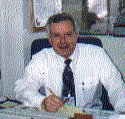
Roger Mack
|
It was in the spring of 1966 when Roger Mack first arrived
at the Clinical Center, and the NIH Police still drove Studebaker
cars, he recalls. Now, 34 years later, Mack looks forward to
restoring a couple of Studebakers during his retirement, which
began last month.
Mack joined the CC in the Inhalation Therapy Section of the
Anesthesiology Department, and became section chief approximately
one year later. Now called respiratory therapy, the specialty
provides breathing support to patients. In the 1960's the specialty
was relatively new.
Under Mack's leadership, the section grew from 3 to 13 people.
He published articles in the "Journal of the American Association
for Inhalation Therapy," and worked with scientists and
inventors to develop respiratory therapy equipment, including
a nebulizer used for patients with cystic fibrosis. He also was
commended by the Joint Commission for his voluminous and accurate
chart documentation with the then new MIS system.
Mack was also one of the original members of the Disaster
Medical Assistance Team (DMAT), which travels to disaster sites
and pitches in with medical help and relief supplies.
When respiratory therapy was one of the areas set to be contracted
out in the early 1980's, Mack left clinical care for administration.
He became a hospital administrative officer (HAO), providing
administrative support to the intensive care and mental health
units.
He received a special commendation from NHLBI for his contribution
to the 1993 design and construction of the 2 West bone marrow
transplantation unit. That project was one of the last he completed
as an HAO.
The past few years have found Mack helping out the Materials
Management Department, where his familiarity with medical equipment
has been invaluable.
In addition to restoring antique cars, Mack's plans for retirement
might include a move to either Florida or to his wife's family
farm in northwestern Pennsylvania.
Reflecting on his years at the CC, he said, "It's been
a very productive and satisfying career. I've especially enjoyed
the opportunity to work closely with patients, some of whom you
see years later. They tell you how much they appreciated all
you did for them, and that's a good feeling."
Back to top
|
Ed Davis retires after 23 years with CC
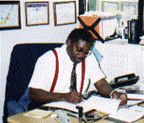
Edward H. Davis
|
"I've seen miracles happen here," said Edward H.
Davis of his 23-year career with the Clinical Center.
Davis retired in February and celebrated with friends and
co-workers at a reception last month in the Visitor Information
Center.
In 1977, after spending 22 years in the Army, Davis was hired
as a respiratory therapist by Roger Mack (see story above). The
two men then led roughly parallel careers and became good friends.
Davis, like Mack, was an original member of the Disaster Medical
Assistance Team (DMAT), and also left respiratory therapy to
pursue a career in hospital administration.
But his fondest memories are of the care he was able to provide
to CC patients. He recalls a patient from the 1970's who'd had
open heart surgery and was on a ventilator while in a coma for
about 8 months. Her mother said the rosary daily. The patient
moved her eyelids one night while Davis was checking her ventilator.
Soon after, she woke up completely. Davis saw her about 3 years
ago in the CC cafeteria, and says she is now married and doing
well.
But as medicine changed, so did the nature of care. Patient
stays shortened, and computers took over some of the functions
therapists performed.
Even during his years in administration, Davis would still
see former patients, one of whom spoke at the groundbreaking
ceremony for the Clinical Research Center.
For Davis, his second retirement still doesn't mean stopping
work. He continues to work with DMAT, doing what he likes best:
helping others.
Back to top
|
Radiology's Ron Norman retires
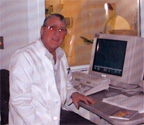
Ron Norman
|
Ronald A. Norman, a technologist with the Computed Tomography
(CT) Section of the Diagnostic Radiology Department, retires
this month after almost 20 years with the Clinical Center.
He joined the Radiology Department in October 1980. Prior
to coming to NIH, he worked at Suburban Hospital for 20 years.
Norman arrived in the D.C. Metropolitan area in April 1958,
where he served in the United States Army at Walter Reed Army
Medical Center.
Although he is a native Texan, he is a true Washington Redskins
fan. He still holds a place in his heart for the Dallas Cowboys,
as long as they are not playing the Redskins.
Norman is a team player who worked together with his colleagues
to provide quality patient care in the CT scan section. He is
widely admired by his peers. Arguably one of his most significant
accomplishments has been his almost perfect attendance record.
Norman has made an enormous contribution to NIH through the
wonderful example he has provided to everyone he has come in
contact with. He is an exceptionally bright, talented, friendly,
and straightforward individual who truly cared for the patients
and went out of his way to do everything possible for them.
His plans for retirement include a variety of activities.
Recently he has become a member of the "Model T Club."
One of his retirement goals is to restore his own Model T. He
would also like to travel the world. When not traveling or working
on his Model T, Norman will be spending lots of time with his
grandchildren. His enthusiasm for baseball may lead him to return
to coaching Little League baseball.
Ron's sincerity, compassion, and friendship will be missed
by all.
--by Nina Carter
Nina Carter is a colleague and friend of Ron Norman.
Back to top
|
CC'ers take part in diversity conference

Standing, left to right, Rona Buchbinder, Walter Jones, and
Deborah Gardner. Seated, left to right, Jerry Garmany, Adrienne
Farrar, and Nicole Butler.
|
A DHHS Conference on Diversity was held on March 1 and 2,
at the Hubert Humphrey Building, downtown. The Clinical Center,
along with other IC's at NIH and other Operational Divisions
within DHHS, nominated staff to attend this conference. Pictured
at left are CC participants.
Kevin Thurm, deputy secretary of DHHS, and the DHHS Union-Management
Partnership Council, composed of senior managers and union representatives,
provide oversight for the quality-of-worklife programs within
DHHS. One quality-of-worklife initiative is to improve managment
of diversity across DHHS, with the specific objective of making
diversity a source of performance excellence.
The Conference on Diversity in the Workplace was one step
in this initiative. The goals of the conference were to develop
a vision for DHHS diversity as a source of equity, inclusion,
and performance excellence, and to make recommendations to achieve
that vision.
--by Nicole Butler
Back to top
|
News briefs
Take child to work
"Take Your Child to Work Day" is April 27. The NIH
purpose is to introduce school children to the vital public services
their parents provide and to encourage children to consider careers
in medical research and the many supporting career fields. With
supervisor approval, employees are encouraged to bring their
children, ages 8 to 15, to participate in the planned events
from 9 a.m. to 4 p.m. Activities include hands-on labs, workshops,
and demonstrations. Preregistration is required for some activities.
Parents should accompany their children to all activities. Contact
Gary Morin at 6-4628 to request reasonable accommodations. Check
the website at http://www.cc.nih.gov/ccc/work/2000.html
for the current list of events. For more information, contact
Brenda Robertson at 3-0913 or Joyce Starks at 2-6068.
Healthier snacks
Looking for a healthier way to snack? Premiering this month
will be healthier food choices in vending machines in the 2nd
floor cafeteria. The machines, located on a wall visible from
the cash registers, will be available 24 hours a day for a 3-month
trial basis. Machines will offer fruit juices and water, coffee/cappuccino,
yogurt, microwave items, including soups, dinners, and health
entrees. But not to fret, in case you have a junk food attack,
chips, sodas, cookies, and candy will still be available in the
vending machines near the back entrance of the cafeteria. The
new vending machines are brought to you by the CC Quality of
Worklife Council, the Nurses Retention Team, and the Wellness
Subgroup.
Construction info
Construction got you confused? If you need help figuring out
what's going on with the new Clinical Research Center, and why
it's happening, check out the following website for the latest
information and photos: http://www.cc.nih.gov/ccc/crcnews/updates.html.
"Protomechanics" available
The third edition of "Protomechanics: A Guide to Preparing
and Conducting a Clinical Research Study" is available from
Clinical Center Communications, 6-2563.
"Change" class
The Education and Training Section of OHRM presents "Managing
Change," May 31 from 9 a.m. to 4 p.m., at 6100 Executive
Blvd., Suite 3E01. Presenter Synde Kalet will teach you how to
react positively and professionally when change is thrust upon
you, find the hidden opportunities in even the most unwelcome
exchange, and go from "panic" to "plan" within
minutes of hearing unexpected news. Call
6-1618 to register.
Back to top
|
Studies
Brain study
NIMH researchers seek children ages 613 years for a study
of how the brain controls finger movements. Children may be healthy
volunteers or those with a diagnosis of Attention Deficit and
Hyperactivity Disorder (ADHD). The study takes 3 hours and involves
a neurological examination, ADHD assessment, and noninvasive
tests. Compensation provided. Call Dr. Marjorie Garvey at 6-5323
for details.
Stutter study
NINDS seeks adults and children age 5 or older who stutter
or have familial speech disorders for an experimental study of
the causes of speech disorders. The study includes speech, voice,
and language testing. There are no study-related costs to participants,
and NIH provides payment for those who take part. For details,
call 1-800-411-1222.
Sleep study
NIMH researchers seek male and female volunteers, ages 2035,
who routinely sleep 9 hours or more per night or 6 hours or less
per night. (Employees of NIMH are ineligible for participation.)
Volunteers must have no sleep disturbances or insomnia, no history
of mental illness, and be in good general health and not taking
any medications or birth control pills. The study requires a
4-day stay on the research unit. Compensation is available. For
details call 6-5831.
Back to top
|
Clinical Center News, 6100 Executive
Blvd., Suite 3C01, MSC 7511, National Institutes of Health, Bethesda,
MD 20892-7511. Tel: 301-496-2563. Fax: 301-402-2984. Published
monthly for CC employees by the Office of Clinical Center Communications,
Colleen Henrichsen, chief. News, article ideas, calendar events,
letters, and photographs are welcome. Deadline for submissions
is the second Monday of each month.
Back to top | cc
home page | nih home
page |
|
|

